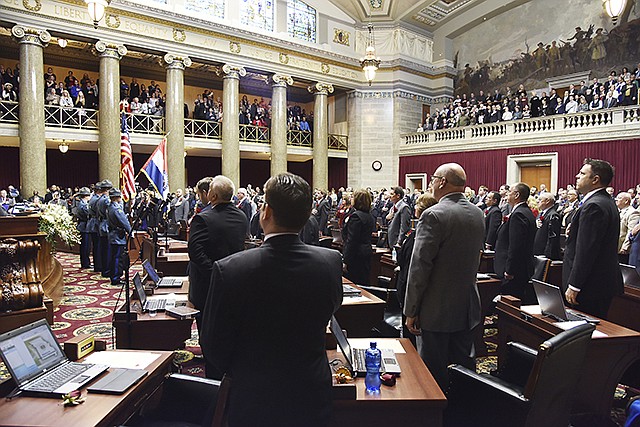JEFFERSON CITY, Mo. (AP) - For the past six years, voters in rural northeastern Missouri have had only one choice for their state representative: a Republican. The same has been true for voters in part of Kansas City, where their lone option has been a Democrat.
Across the state, the number of Missouri House races lacking Democratic or Republican candidates has risen significantly since legislative districts were last redrawn after the 2010 Census. An Associated Press analysis found those districts also have produced a consistent Republican advantage that has helped swell the GOP's majority to some of highest levels in state history - higher even than what would be expected based on Republicans' share of the vote.
The AP analyzed the results of last fall's U.S. and state House elections across the nation, examining the percentage of races lacking major party opposition and calculating state partisan advantages using a statistical method designed to detect potential political gerrymandering.
The amount of partisan advantage favoring Missouri Republicans was fairly typical when compared with other states. But Missouri ranked in the top tier of uncompetitive states, with nearly 60 percent of its state House winners lacking a major-party opponent. That's a spike upward from about 50 percent uncontested races in the previous two elections, and around 40 percent during the first decade of the 2000s.
Although most of Missouri's unopposed candidates were incumbents, some newcomers seeking open seats also cruised to victory without major-party opponents. For some candidates - such as Republican Rep. Craig Redmon in northeastern Missouri and Democratic Rep. Gail McCann Beatty in Kansas City - 2016 marked the third straight election in which they were the only choice on the ballot.
Part of the reason may be a political climate of costly, negative campaigns that discourages potential candidates, said Beatty, the House minority leader.
But "part of it is the gerrymandering issue, in that districts are simply drawn in such a way that it is very difficult" for Democrats to win in many parts of the state, Beatty added.
Other districts - such as Beatty's, where 9 of every 10 voters favor Democrats - are virtually impossible for Republicans to win.
Redmon said political "apathy" and eight-year term limits are partly to blame for a lack of candidates, as potential challengers simply wait until incumbents can no longer seek re-election. But he also agrees partly with Beatty.
"I can look at the map - and I'm not a political analyst - and see that it favors the Republican Party," Redmon said.
Missouri's 163 House districts were drawn in 2011 by a six-member panel of state appeals court judges after a bipartisan citizens' commission failed to agree on a plan. The judges - three of whom had originally been appointed to the bench by a Republican governor and three by a Democrat - reviewed proposed maps from the Republican and Democratic commissioners, as well as suggestions from individual lawmakers and residents. Their final map, agreed to unanimously, didn't mirror any particular one of those recommendations.
"My initial reaction when I saw it was that it did not favor our approach," said Joe Maxwell, a former Democratic lieutenant governor who had been chairman of the unsuccessful citizens' commission.
Yet there also were some districts that didn't appear to follow the Republican proposal, said former citizens' commission member Nick Myers, who now is secretary of the Missouri Republican State Committee.
Missouri's redistricting office analyzed the new House districts in 2011 by applying a decade of past election results. Its analysis showed that although Democrats had a 51 percent to 49 percent vote edge statewide over Republicans, the GOP had a majority in 102 of the new House districts compared to just 61 for Democrats. Barely one-fourth of the new districts were labeled as competitive between Republicans and Democrats.
Republicans, who held 106 state House seats after the 2010 elections, have fared even better under the new map. The GOP won 110 House seats in 2012 and 117 seats in 2014 and 2016.
The AP analyzed the 2016 election results using an "efficiency gap" formula developed by University of Chicago law professor Nick Stephanopoulos and researcher Eric McGhee of the nonpartisan Public Policy Institute of California. The formula focuses on "wasted votes" - those cast for losing candidates, and for winners beyond the needed majority - to determine which party is more efficient at translating votes into victories.
A sizable efficiency gap suggests an advantage for one party - perhaps because large numbers of voters for the other party were packed into a limited number of districts while voters for the majority party were distributed more evenly, creating more winnable districts.
Missouri's state House efficiency gap score favoring Republicans was close to the median of all states analyzed, resulting in about six additional GOP seats over what would have been expected based on the average vote share Republicans received in the districts.
A previous efficiency gap analysis conducted by Simon Jackman, a former professor of political science and statistics at Stanford University, found that the Republican advantage was even higher in the 2012 and 2014 Missouri House elections.

